
Would you like to start a conversation with other industry leaders to brainstorm a challenge or to just know more on a particular topic?
Engage in online discussions with your Peers
Start Now“You’ve got to start with the customer experience and work back toward the technology, not the other way around.” – Steve Jobs
Over the last two decades, the effectiveness of offshoring has been often associated with the succinct mantra ‘come for cost, stay for quality and grow on value’, thereby giving a clear indication that cost save is, at best, a starting point for business process transformation, never the end in itself. In many ways, for Indian corporations, the reality to go beyond cost saves has become more than necessary in view of the huge change management requirements to adopt the Business Process Management (BPM) as a strategy. Be it, a Global In-house Centre (GIC), or India Shared Services or a BPO, the key differentiator for the value story is clearly about customer centric delivery, beyond cost saves!
Customer Is At the Core of Transformation
As published by the Shared Services Forum in the book ‘BPM in Global India – The Inflection Point for Competitive Advantage’, the holistic description of BPM, whether off shore or onshore, encompasses 4 aspects – Consolidation, Systems, Skills & Capabilities and Transformation. While Process is the middle name of BPM, Customer is at its core. Cost, Quality or Value benefits, without delivering or enhancing a holistic Customer Experience, cannot even enable, leave alone sustain, the positive impact of any transformational initiative.
the holistic description of BPM, whether off shore or onshore, encompasses 4 aspects – Consolidation, Systems, Skills & Capabilities and Transformation. While Process is the middle name of BPM, Customer is at its core. Cost, Quality or Value benefits, without delivering or enhancing a holistic Customer Experience, cannot even enable, leave alone sustain, the positive impact of any transformational initiative.
The task begins with considering the customer - not the organization – at the centre of success. Customer Experience Management (CEM) refers to creating value through transforming collective processes to manage series of customer interactions as journeys. By design, this is much beyond one or more touch points - to the entire journey of the customer, and that too, from the customer’s perspective. Every Process Centric Enterprise truly needs to include driving the end-to-end process to deliver greater customer experience for sustaining value creation.
Customer Experience Management (CEM) refers to creating value through transforming collective processes to manage series of customer interactions as journeys.
While the ‘Service Profit Chain’ has been public knowledge since late 90s (and familiar to GICs), McKinsey recently confirmed in their research, “...with advance analytics, Customer Experience Leaders gain rapid insights to build customer loyalty, makes employees happier, achieve revenue gains of 5 to 10%, reduce costs by 15 to 25% and enhance Net Promoter Score by 15%, within 2 or 3 years”.
Successful companies like Amazon, Disney, Apple and Google firmly believe and are committed to the principle that they are, in fact, in the business of customer experience! The world of BPM needs to totally reboot from some of the past glories on customer focus, rejig their tools and techniques to prepare and come alive to the ‘next generation of customer centricity that focuses on customer experience’.
Towards NextGen CEM - BPT to CET
With the world changing around the customer and customer experience, BPM needs to reinvent itself to deliver greater value. People, Process and Technology are important but they still are enablers to the Customer, Business and Value which are the outcomes, within a secured and controlled environment.
It is given that any change arising from BPM projects – be it process, technology, structure etc., primarily impacts all people (employees, customers and other stakeholders). Hence, any initiative that is focused on business process management or transformation is best renamed as ‘Customer Experience Transformation’, to give the right emphasis and strategic attention to achieve this as key business outcome.

…the SIPOC to COPIS change has even now remained just a concept
- neither penetrating nor becoming embedded as part of the BPM
practice! Hence, this change has not made the desired impact
towards customer centricity!
Of course, mere change in form will not make the change in substance. Three major actions will be required for moving from BPT to CET.
They are:
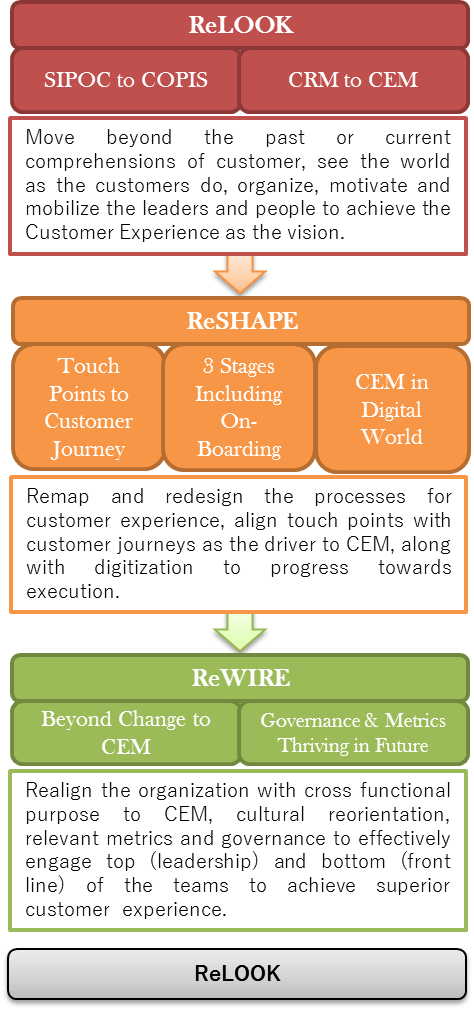
SIPOC to COPIS: Has this remained a Concept?
One of the first changes in the BPM evolution that the GICs recognized the role of ‘customer’, is the reversal from SIPOC - ‘what the process can give’ to COPIS - ‘what the customer needs’ and align/drive the process in that direction. This is a shift from the supplier as the starting point to move to customer / customer requirements as the starting point, which gives better focus to deliver the output.
Interestingly, the above change is more than a simple reversal of the flow from customer to supplier; it demanded a significant shift in the mind-set to recognize various customers’ individual needs and make the customer as the starting point really happen. As this shift has not happened, the SIPOC to COPIS change has even now remained just a concept - neither penetrating nor becoming embedded as part of the BPM practice! Hence, this change has not made the desired impact towards customer centricity! This is not to say that customer is not focused at all by the leaders or teams, but it only indicates that customer has not fully become the ‘core’ of business services in all its actions and initiatives.
Even after 2 decades of growth of this industry, the mind-set for not having the right level of customer engagement continues to be the single largest detractor to speed up implementation of or realize value from business process transformation strategies. If the customer becomes the core of all such initiatives, the change management challenges also get suitably addressed and true transformation takes effect, much beyond change.
Only CRM: Inadequate For the Future?
For the front office processes in Customer Lifecycle Management, the BPM industry has always recognized the criticality of ‘customer’, as they are, by design, customer facing processes. Most companies deploy advanced technology systems and tools, to meet or exceed expectations in that interaction, including on line CSAT surveys. However, these efforts tend to focus ‘essentially for that interaction’ as customer relationship management (CRM) and the customer is still not at the core of the business.
If the above focus is relevant to front-office customer interfacing processes, then it becomes even more applicable for processes that are back office, IT services or even analytics and knowledge processes, where typical CRM processes or related technology support is prevalent only in a muted way, as they are mostly non-voice based. Even today, companies, at best rely merely on annual CSAT surveys which are too generic, and are too generic, and have just no linkages to customer interactions which deliver the output from the customer perspective!
Simply put, CRM focuses at best on touch points, while CEM
connects the entire customer journey.
Some BPM organizations use Voice of Customer (VOC) as a selective tool during process transformation projects but it needs to become an integral part of an enterprise to drive customer centric behaviour. Some leading organizations utilize Net Promoter Score (NPS) from customer satisfaction (CSAT) surveys as a key indicator, but instead of NPS being a stand-alone focus and once-a-year feedback, it needs to be connected to a holistic Customer Experience plan in place.
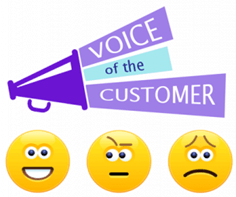
As companies move up the process value chain, it is becoming imperative to focus beyond process, service and even customer relationship, which are more an inside-out approach, to holistic customer experience, which is an outside-in view - to see the world through the customer’s eyes. It is all about how the customer ‘perceives’, and not what the company thinks it is delivering!
Extensive research has been carried out over the last three years by McKinsey and Harvard Business School that has proven the need for companies to move beyond CRM and focus on CEM i.e. ‘how’ an organization delivers to the customer, is beginning to be as important as ‘what’ it delivers. Simply put, CRM focuses at best on touch points, while CEM connects the entire customer journey.
The Harvard Business Review Analytic Services of more than 400 executives around customer experience management—research that features in-depth interviews with several best-practice company leaders—highlights the following two key findings:
- 53% of the leaders believe that Customer Experience provides a competitive advantage, and
- 45% of the leaders view Customer Experience Management as an important strategic priority.
Considering this shift happening around product & technology organizations, BPM focused organizations will immensely benefit to focus on CEM as part of their organizational vision and strategy, and this can become a key differentiator to competitive advantage.

Touch Points to Journeys
GICs and Indian SSCs focus on three major links, with many touch points within each: Internal Customer (Internal to the Company – Functional and/or Business customers), Cross Functional Connect (multifunctional internal customers, cutting across functional boundaries) and End Customer (the real and most complex link in the customer journey in a multi-channel multi-connect environment).
Until recently, when most companies focused on CEM, they thought only touch points i.e. the ‘individual interactions’ through which customers interact with various links or parts of the business as required for their interaction. While this logically reflects the way organizations would like to identify individual accountabilities (like sales, customer service, billing, collections, etc.), this silo focus misses the big picture of end-to-end customer experience.
Unlike touch points that generally last for a few minutes or a few hours, customer journeys will include many things that happen before, during, and after the experience of a product or a service. Journeys can be longer, stretching across multi-touch and multi-channel, and often lasting for several weeks. Customer journeys, being cross functional by nature, require cutting across traditional organizational boundaries, and changing this dynamic is key for improving CEM.
McKinsey Research has discovered that companies fail to appreciate the ‘connect of the individual situations to the customer journey’ and miss to manage the cross functional end-to-end experience that shape the customer’s view of the entire business across all touch points.
Taking a simplistic multi-channel contact centre example, even if teams execute very well on individual touch point interactions, the overall experience can still disappoint, as indicated below:
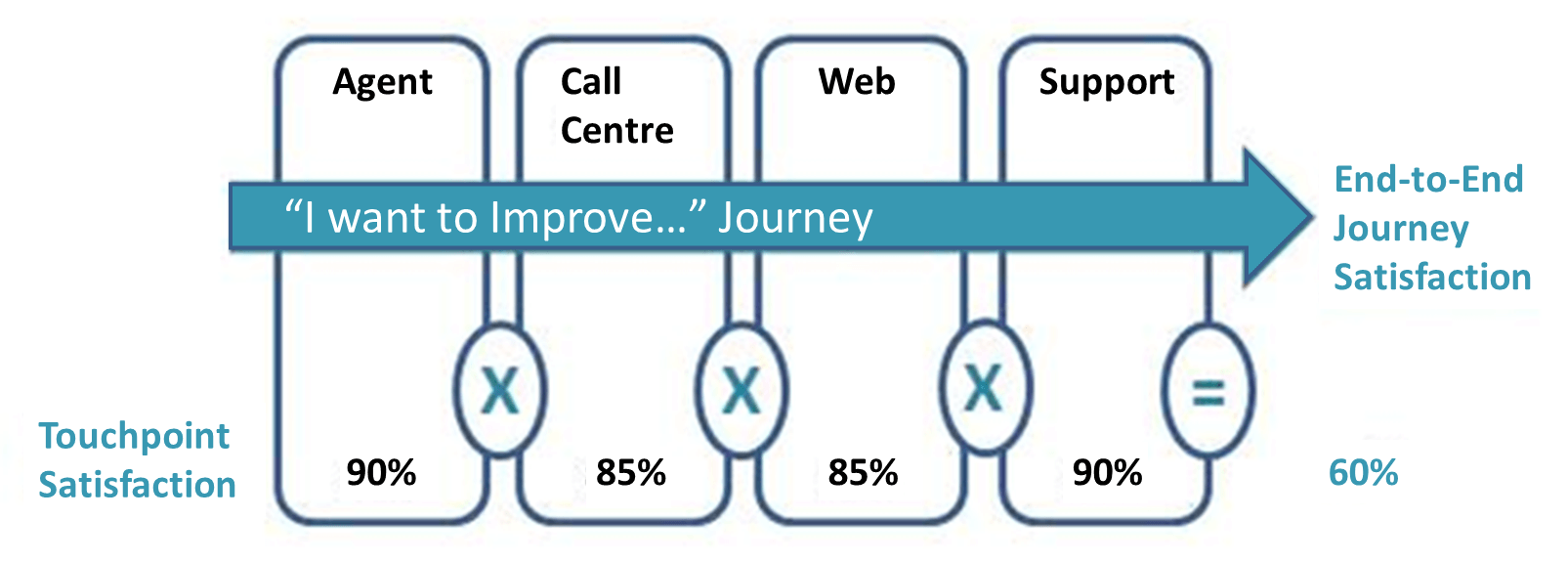

Best in class companies optimize customer journeys and not just touch points. One experience of observing customers ‘opening a new bank account’ in a global bank, the customer journey has ‘four’ touch points to make the account fully operational as depicted below:


The McKinsey research reveals that customer journeys are more significantly correlated with business outcomes as compared to touch points. Customer satisfaction with health insurance is 73% more likely when journeys work well, and similarly, customers of hotels may be 61% more willing to recommend when they get their journey right. If journeys are effectively managed by a company that company would automatically will do the best job with the touch points i.e. understand the context of the interaction, address the root cause for the query, and create the feedback loop to improve the upstream and downstream interactions that surround the query.
CEM Has To Start From On-boarding!
Any customer in the BPM domain, internal or external, be it for GICs or SSCs or BPOs, experiences THREE big stages of journey:
- On Boarding – from Project to Process
- Service & Delivery – on-going fulfilment of regular and Ad hoc deliverables
- Transformation – Implementation of Process Improvements & Initiatives
Each of the above three stages has its own demands and differentiators to enable customer experience.
The customer really starts the journey with the experience of on-boarding, which covers many touch points like transition of processes or digital transformation impacting the processes. This is a typical ‘project to process’ journey with the customer on-boarding happening as the Go Live happens. This journey spans over 4 to 6 months, and involves several touch points in the form of process interactions, project reviews, solution design, documentation review, service level base-lining etc. Our research proves that, at each touch point, the interaction had at least 90% chance of going well. But average customer satisfaction fell almost 40% over the course of the entire journey, as the process go-live starts. The touch points were not broken, but the on-boarding process as a whole was!
Despite advanced transition methodologies in place, the customer on-boarding process continues to be a challenge. Many organizations still do not seek customer feedback after this very first experience, since they fear that the scores will be quite low. In some ways, the preconceived notion that customers will have to live with a dip in service levels just after go-live, could also be a reason for not-so-good customer experience. It is not the dip in service levels, but how well the SSC team handles the challenges faced by the customer and enables positive customer experience when there is a challenge, is the differentiator.
Customer on-boarding journey is one area that can make a huge difference to the customer, if the end-to-end journey is managed well across all interactions. Applying this ‘nextgen’ mind-set and practice in a recent ‘pioneering’ offshoring transition has really triggered positive customer experience on Go Live. This was achieved through:
- clear focus on the ‘customer journey covering all touch points’,
- the belief that outstanding program management expertise has to engage all stakeholders, and
- addressing / responding to key situations that might impact ‘dip in quality’ from the ‘customer’s perspective’, much before the formal Go Live!
In the Service & Delivery Journey, customers experience delivery of services on a regular basis as per SOW and SLA and for certain Ad-hoc requirements that come up on need basis. This is possibly the predominant span of experience and from the customer’s perspective, the Service/ Delivery stage may even have multiple journeys! Each journey will have multiple touch points including occasional service variations/ dips due to team churn at the centre, new metrics and KPIs dashboard for visibility and control, urgent requirements outside SLA, additional support required due to unusual work at the customers’ end, and so on. This stage (one or more journeys) provides the SSC leaders the best opportunity to ‘move up the relationship value chain’ and deliver better customer experience through value added services - much beyond the SLA.
The more progressive GICs/ SSCs consider ‘employees’ too as customers, depending on their journeys, as in the case of internal business customers as well. Some of the GICs or leading Indian SSCs have moved towards ’multifunctional’ integrated shared services model to achieve greater agility in responsiveness and improved quality and consistency in customer delivery. They have enhanced their focus on their core business customers, to continuously enhance customer experience and drive value to the top line and bottom line benefits.
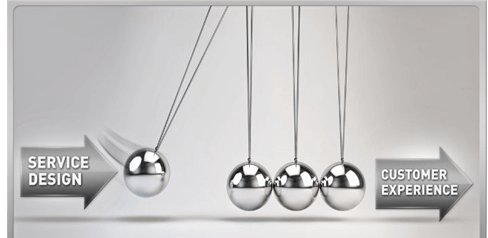
The Transformation journey could be a combination of improvement/ strategic initiatives at the SSC end or at the business internal customer’s end. In all these, presently, Process Maps are focused only on ‘delivering an output’, of course to a customer; but, the organizations do not even visualize ‘delivering a customer experience’. The customer experience ‘happens’ more as a consequence to delivery of product, service or output, and practically speaking, there are just no process maps currently available that will have customer experience as the specific and focused business outcome. Companies have to reorient their process mapping from output to customer experience, and build this as their DNA. GICs/ SSCs will greatly benefit to incorporate this as a ‘next practice’ in all their Business Process Transformation project implementations.
Customer Experience in the Digital World
Customers who are used to the efficacy of the ‘digital experience’ with Google, Amazon and Apple, are now not at all averse to digitalizing the customer experience process; and the companies too will stand to gain by digitalizing the processes behind the most important journeys. Given the multi-touch, multichannel interactions of the customer, the technology, digital systems and tools really ‘integrate’ the collection and carry out sorting and big data analysis of the immense information that is captured by the systems.
In fact, without digitalization, future of customer experience management will be a nightmare. This becomes quite evident since the touch points management and thinking is NOT at all replaced. Instead, the journey management is added. In other words, the expertise, efficiencies and wisdom that functional groups bring to the table will continue to represent invaluable insights, particularly in the fast-changing digital arena. As the Harvard Business Review survey indicates, leading edge companies are embracing new technologies and tools and are extensively using big data analytics to track/ monitor touch points and journeys together. The over emphasis on AHR and IVR need to be mitigated, and there is a need to recognize that customer experience has to be the real outcome even for productivity improvements from systems and tools, not just cost saves.
As per the HBR Analytic Services study, “leading-edge companies place more importance on a number of technologies for customer experience management, including online surveys, marketing operations management, real-time decision-making tools, social media monitoring software, and content management systems. They recognize the importance of emerging analytics technologies, including systems that analyze online behaviour, social media sentiment, and text as well as tools that can deliver real-time analysis of large data sets. Integrating all the necessary tools is a challenge, but leading-edge companies devote the resources to create a cohesive customer experience ecosystem”.
As said earlier, the best examples in leveraging emerging and innovative technologies are Google, Amazon and Apple, and their ‘secret to success’ is using these digital tools, without losing the ‘personalization’ effect for the customer to have a solid customer experience value. Many organizations need technology even to map and capture the customer experience processes in the first place, to address the transformation required to enhance CEM. One of the survey findings from the HBR Report is given under:
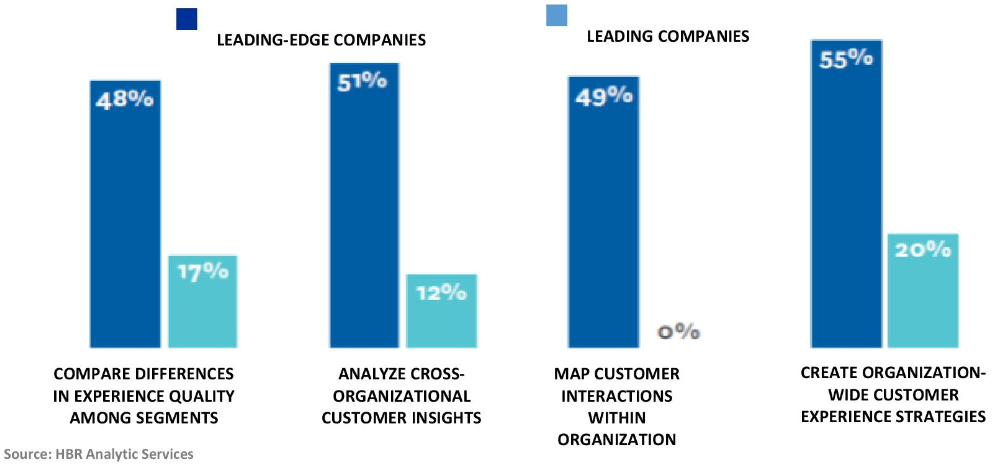

Beyond Change to Customer Experience
Change management has already a specific pre-requisite for successful implementation of new strategies and initiatives. While such change management quite often does include or club customer requirements, it is never considered specifically as ‘customer experience’. In most of the BPM initiatives, change management as a strategic process works best essentially for leadership and employees i.e. people within an organization, since the employees overall look at why change and what’s in it for me (WIIFM) to adapt or embrace the change.
However, change management as a process has serious limitations for dealing with changes meant for customers – be it, internal or external. This is so because Customers do not focus on change, they focus only on value. If the change leads to value as they perceive i.e. positive customer experience, then they accept the change, otherwise they don’t! Hence, organizations have to retool their approach to include CEM as a specific focus, besides change management, when any strategic initiative is designed to make changes to customer experience or perception.
Governance and Metrics – Thriving in Future
The future clearly belongs to Customer Experience. With technology/ innovation and volatile and start-up competition being the order of the future, CEM is a sine qua non for any business that wants to be successful and plan to be around for a long haul.
The Top FIVE observations on CEM on emerging governance and metrics based on available research and our direct experience are:
- So far, Business Models are being referred to as B2B or B2C as though companies control the customer demand with products and services. But, as Bill Price and David Jaffe researched, a new ‘Me2B’ world is emerging in which the customer directs the relationship - a world in which the customer, not the business, dictates the terms of engagement. In order for the business organizations to thrive in future, creating positive experiences will become critical to fulfil a range of customer needs. The first change will be that CEM will become a strategic priority in the next few years across Manufacturing, Services, Technology and BPM Organizations, and will mature over a period of time.
- Business KPIs and Corporate rewards will be connected to Customer Experience Metrics, besides shareholder value creation. Metrics like brand mentions/ recalls, Customer Lifetime Value, Social Media sentiments etc., will take precedence as measures of success. From India point of view, recognition of NPS as a key driver will also gain greater importance.
- New technologies/AI tools focused on capturing, personalizing and analyzing customer experience and the related processes – interactions, engagement, behavioural requirements, emotions, perceptions etc., will find their way into the business canvas. CEM will occupy a key role in Big Data analytics/ tools.
- CEM or CX as it will become, will also require focus and be built on EX (Employee Experience) and WX (Workplace Experience), as the fastest growing areas of ‘experience design’. Millennials and Mobile will matter for ever for CEM. Mobile will be the integrator for Omni channel reach to provide anytime / anywhere access to Customers.
- Moving up the Relationship Value Chain will become an integral part of the BPM for all GICs/ SSCs/ BPOs. Typically, these organizations will move from Process to Delivery to Engagement and finally to Experience, that will transform the role of a Service Provider into an Enterprise Partner based on maturity of CEM.
CEM – The Aspirational Journey in Itself!
Trends and research in Customer Experience Management clearly indicate that the business environment of this Global India is ready for giving a specific impetus to focus on CEM. With the ecommerce, on-line platforms and urban road transformation in India growing its presence, the Global India is integrating even more with the ‘demanding customer world’ of the developed countries and raising the position of customer as well as the socio-economic standards of living.
When the end to end customer journey across four value
dimensions aligns together, the Value Exchange is achieved to
drive the ‘business of customer experience’!
The focus and aspirations of organizations on CEM will vary depending on the vision and application of the three-step strategic execution plan – Relook, Reshape and Rewire! For few, it could be a steep change, for some it could be a step change and for some other, it could be modest or incremental. One common feature organizations are discovering is that the Customer Experience will eventually be a function of ‘value exchange happening across the customer life cycle of journeys – recognizing Value in FOUR dimensions: Value Proposition, Value Perception, Value Expectation and Value Realization.
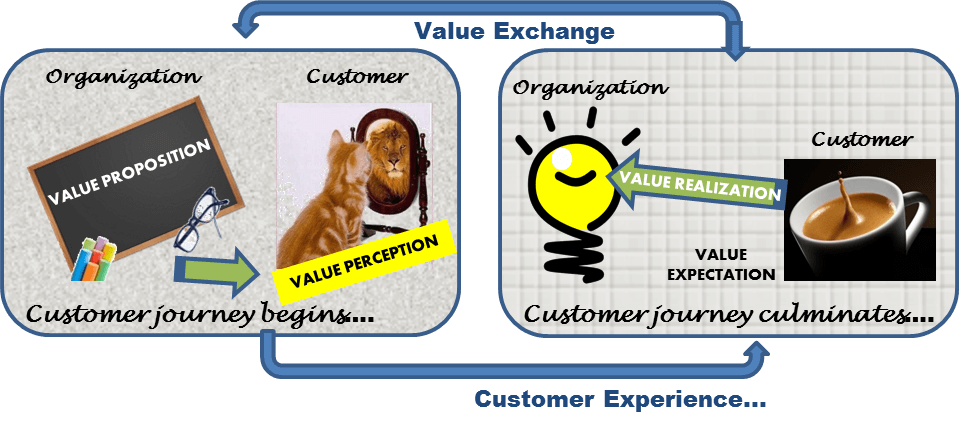
When there is an alignment of Value Proposition and Value Perception of that proposition, the customer journey begins. And, when there is an alignment of Value Expectation and Value Realization, the journey culminates into an excellent customer experience.
When the end to end customer journey across four value dimensions aligns together, the Value Exchange is achieved to drive the ‘business of customer experience’! And, this helps the organization to move beyond the inside-out change of leadership and people engagement to outside-in customer engagement, leading the organization towards the value creating Customer Experience Transformation!
ABOUT THE AUTHOR

Ravi S Ramakrishnan is a seasoned business and people leader with invaluable experience of 35 years in finance, business and business process areas. He was instrumental in setting up the pioneering global offshoring operations at American Express. Having held leadership positions earlier in Hindustan Unilever, Murugappa Group and Eicher with CXO level responsibilities,
Ravi is recognized as a thought leader in off shoring and business process domains. He uniquely combines exposure to multiple sectors of Indian and global corporations, and drives the vision and strategies for growth of RvaluE in the niche area of business process services through a team of professionals. Ravi is a Chartered & Cost Accountant and a Company Secretary.








